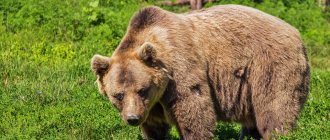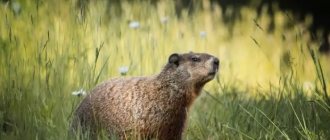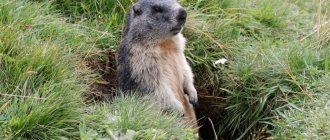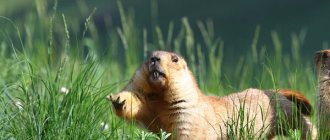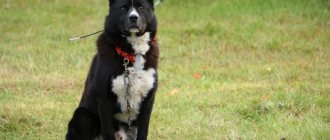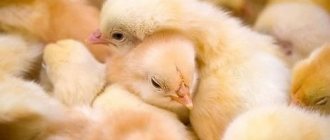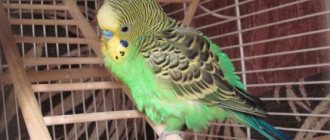Is it possible to keep a groundhog at home?
Marmots are very sociable animals, they easily learn to go to the litter box, they like to play with their owners and sleep in the same bed with them. Often, owners allow their marmots to move freely around the apartment. ... The best compromise is to lock your groundhogs in a cage when leaving home.
Interesting materials:
How to set your own melody for beeps? How to install a widget in a VKontakte group? How to install the VKontakte my guests function? How to install a second line on MTS? How to install Wicked Whims? How to install Windows XP on a USB flash drive? How to reinstall Viber? How does a flash drive work? How does an oil pump work? How does a sword work?
Wintering houses in the Pushkin State Animal Farm. Photo by E. Goryaynova
“Sleeps like a groundhog” - this saying did not arise out of nowhere. Sleep for a groundhog is of great importance, because... The animal spends two thirds of the year in a state of hibernation.
The year for a groundhog can be divided into two periods: active and inactive. Active - these are the spring and summer months. For this, the marmot gains fat necessary for hibernation, which lasts 5-6 months, i.e. almost the entire autumn-winter (inactive) period.
But even when they are active, marmots also pay special attention to sleep. Sleep during this period can also be divided into two phases: spring-summer and summer-autumn. The groundhog spends the first period of approximately half of the daylight hours in a state of “feeding,” “fattening” the fat that he will need in the winter. As the groundhog gains the required amount of fat, its activity decreases, and it spends more and more time sleeping.
In the wild, at the end of August - beginning of September, marmots settle only in permanent and wintering burrows in families and groups from 2-5 to 20-24. They close the entrances to an occupied hole with plugs made of a mixture of earth and stones and fall into deep hibernation, which lasts for six months. During this period they do not feed, since they do not collect food reserves in their burrows. Energy expenditure during hibernation decreases tenfold, and in the spring, at the end of February - beginning of March, when there is still snow everywhere, they awaken even well-fed, with a reserve of about 100-200 g of fat.
In the case of stable feeding conditions (with a uniformly wet autumn), the period of activity of individual individuals can last until the 3rd decade of November.
Recent studies have shown that marmots, during hibernation, wake up approximately once every three weeks for twelve to twenty hours. Most likely, this is necessary to stabilize the life processes of the body, i.e. its kind of “warm-up”. It is at this time that the groundhog spends most of its accumulated fat, which acts as an energy resource. But when they come to the surface, the awakened marmots, as I have already emphasized, are not skinny at all. The bulk of fat reserves is consumed in the first three weeks after hibernation, until the young grass grows.
A marmot living with a person, like its wild counterpart, must also sleep. You can't fool nature. Long sleep is a physiological need of the groundhog. Therefore, if you cannot create conditions for the groundhog to hibernate, then it is better not to get this animal at all, because... Lack of proper winter sleep can have fatal consequences for a groundhog.
So, it’s decided, let’s put the groundhog into hibernation. To hibernate at home, the marmot should prepare a house. The house is a large box that opens from the top. For one marmot, a box measuring 60x60x60 cm, 2/3 filled with hay, will be sufficient. To protect the walls, the inside of the house must be covered with metal mesh - that’s all, the house is ready for wintering.
| 1. The process of assembling a house - a box for hibernation of a marmot. The sides are attached to the bottom. The external size of the box is 72.5x72.5x72.5 cm. | |
| 2. The process of assembling the house. A glazed loggia has been allocated for the wintering area of marmots. In winter, the temperature on the loggia is on average 10 degrees higher than outside. | |
| 3. The house is fully assembled. All that remains is to fill it with hay for wintering. | |
| 4. Hay for wintering. Three bags of hay were purchased. It turned out to be a lot. For hibernation you will need, at most, a bag and a half. |
At home, you should decide on a wintering location. Any unheated room, protected from drafts and sudden temperature changes, is best suited for these purposes.
Here you can see photos of marmots hibernating.
For some time before going into hibernation, the groundhog becomes lethargic and eats little. Approximately two weeks before burial, the animal’s mobility decreases: by this time it has completely finished molting. The animal eats little food, gradually emptying the intestines. By the time of hibernation, the yearling marmot (marmot born this year) weighs 4.5-5 kg. Lettings and two-year-olds weigh more - 8-9 kg. The figures given here do not apply to marmots living in the wild.
For reference, Table 1 provides information on the assessment of marmots of the year at the Pushkin State Animal Farm, which is carried out in August every year.
To eat and meet other needs, marmots can initially be released from the house through a side door. Over time, the need for such exits disappears and the groundhog falls asleep.
In a good way, the groundhog should be put to bed at the end of September - beginning of October, but if the temperature outside is above zero, the groundhog will not sleep. He falls asleep when the ambient temperature drops to 3 degrees. During hibernation, the temperature in the house should be maintained at 3-4 degrees, but not higher. In October, at the beginning of hibernation, marmots can be easily awakened, but later this is not easy to do.
The body temperature of a sleeping animal drops significantly to 3-5 (the normal temperature of an animal is 35.5-37.6), breathing slows down - one breath every few minutes, heartbeat 3-6 beats per minute, i.e. it's almost invisible. When you see a sleeping groundhog, you get the misleading impression that the groundhog has died.
Once again, I would like to remind you that marmots do not eat or drink water during hibernation. Therefore, I would like to say a few words to the owners of marmots whose pets are insufficient weight for hibernation: animals that have not “fed up” a sufficient amount of fat do not fall asleep longer in the fall. Therefore, in order to avoid starvation and possible death of the animal, a certain amount of “safety” food should be placed in the wintering house, which will be eaten by the animals during winter awakenings.
Marmots tolerate low temperatures better than high ones. They safely tolerate an ambient temperature of 30 degrees. During hibernation, the animal’s body becomes immune to infectious diseases. Over the winter, adult marmots lose 36%, and yearlings lose 28% of their body weight.
Sometimes, marmots living at home, even with the onset of winter, do not want to hibernate. They are still active, eating and drinking a lot. What to do? The simplest thing that can be done in this situation is to artificially prepare the animal for sleep. Once again I want to say that this method is applicable only when cold weather sets in. To do this, it is necessary to place the groundhog in “winter” conditions, i.e. into a wintering house prepared for hibernation for several hours. It is advisable to do this not at night, because... how the night temperature is very different from the day temperature. After the animal has been in the house for several hours, it will most likely burrow into the bedding and fall asleep. It should be removed from the house and moved to a warm room. Every day for a week, increase the time the groundhog spends in the wintering house.
It should be noted that you should not immediately leave the groundhog in the wintering house, because... The animal’s body still contains water and food residues. They need to be removed from his body...
After you start the hibernation mechanism, you should reduce the animal’s consumption of food and water... About a week after the start of hibernation, the marmot can be left in the wintering house.
In conclusion, I would like to say a few words to marmot owners who do not hibernate their pets. In domestic marmots that have not hibernated, their waking time is noticeably reduced; a marmot sleeps two to three times more than it does not. This sleep is not a complete replacement for winter hibernation of many months, and over time, the domestic marmot may develop health problems due to “lack of sleep.”
Copyright © 2005 Lukyanov Sergey
When do the Baibaks wake up?
Boibaks wake up from hibernation in the middle or end of March and early April. Having fattened up a little, they begin to repair or re-dig protective burrows, and later correct and expand the old living burrows.
Interesting materials:
How much does it cost to register with the Assay Office? How much does it cost to chip a dog in Ukraine? How much does it cost to promote an ad on Avito? How much does it cost to travel in Tomsk 2022? How much does shoe stretching cost in Moscow? How much does a new Renault Captur cost? How much does a 1c specialist certificate cost? How much does a kebab cost in a magnet? How much does it cost to tap walls for pipes? How much does the Chaika 143 sewing machine cost?
Spreading
In the past, boibak was widespread throughout the steppe and partly forest-steppe zone from Hungary to the Irtysh (absent in the Crimea and Ciscaucasia, but currently boibak is observed in the steppe part of Crimea, on the Tarkhankut Peninsula), but under the influence of the plowing of virgin lands it disappeared almost everywhere, surviving only in areas of untouched virgin lands on the Don, in the Middle Volga region, the southern Urals and in Kazakhstan. Now the bobak lives in the Rostov, Volgograd regions, Belgorod, Voronezh (Stone steppe between the Bityug and Khoper rivers, Bogucharsky, Kantemirovsky and Rossoshansky districts), Kursk region, Samara region, in the northeast of Saratov, in the south of Ulyanovsk and Nizhny Novgorod regions, and also in Chuvashia, Tatarstan and Bashkortostan. On the territory of Ukraine it is found in several isolated foci in Lugansk, Sumy (Romny district), Kharkov and Zaporozhye regions. Beyond the Urals and Northern Kazakhstan, its range is less fragmented; here boibak is found from the river. Ural to Irtysh: in the Orenburg and Chelyabinsk regions, in the south of the Omsk region of Russia, in the northern part of West Kazakhstan, the western part of Aktobe, Kustanay, North Kazakhstan, in the north of Karaganda and in the East Kazakhstan region of Kazakhstan.
What happens to an animal during hibernation
A sleeping marmot does not consume food at all throughout the entire period of hibernation. At the same time, the following processes occur in his body:
- Digestion stops, but the secretion of gastric juice does not stop;
- blood circulation slows down, the blood thickens, the largest vessels of the thoracic and abdominal cavities become overfilled with blood;
- blood supply to the brain and meninges becomes minimal;
- breathing slows down;
- oxygen consumption and carbon dioxide emissions are reduced;
- glycogen accumulates in the liver in the complete absence of glucose in the blood;
- bile thickens and the gallbladder becomes full;
- body temperature drops to 4.6°
Important! Since the number of heartbeats and respiratory movements is reduced to 3-5 per minute, inexperienced owners may think that the pet has died. It’s not for nothing that there is a common expression “sleeps like a groundhog.”
During the wintering period, the marmot loses from 28 to 36% of its weight. The remaining fat allows it to survive for 2-3 weeks after awakening until there is enough grass to feed on.
In the course of numerous studies, scientists have come to the conclusion that such deep immersion in sleep is due to the high concentration of carbon dioxide that accumulates in the hole as a result of the animal’s breathing.
Reproduction
In March - April, the bobaks begin their mating season. Their pregnancy lasts 30-35 days; a litter usually contains 3-6 cubs. Newborn marmots are naked and blind, 9-11 cm long and weighing 30-40 g (this is about 1% of the mother’s weight). Their eyes open only on the 23rd day. During pregnancy and milk feeding, the male moves to another burrow. The female feeds milk for up to 50 days, although at the age of 40 days, in late May - early June, marmots already begin to eat grass. It was previously believed that marmot families consisted of parents and two broods of young children. But observations of tagged animals have shown that some of the yearlings leave their family and settle in other families as foster children, and their parents, in turn, accept other people’s cubs. Marmots stay with their parents until next summer, after which they build their own burrows. But they also spend the second wintering with their parents. Young marmots reach sexual maturity only at 3 years of age.
Interesting Facts
On February 2, residents of the United States and Canada celebrate a very unusual holiday - Groundhog Day. It is believed that by the behavior of an awakened rodent one can determine the weather for the next month and a half.
If this day is cloudy and the groundhog calmly leaves the hole, then spring will be early. But if the day turns out to be sunny and the rodent hides back in the house, then winter will last another 6 weeks.
This tradition has nothing to do with the real forecast, since domesticated marmots participate in the ceremony. However, these festivals attract a large number of tourists, which is very beneficial from an economic point of view.
Unfortunately, most rural residents have a negative attitude towards wild marmots. These rodents are credited with eating large portions of crops, digging holes in which horses then break their legs, and spreading diseases that are dangerous to humans.
And, despite the fact that some facts are not substantiated, the animals were mercilessly destroyed for a long time. In addition, the meat of these rodents is considered a delicacy, and high-quality warm fur is excellent for sewing winter clothes. All this has led to a critical decline in the numbers of many species of marmots, and some of them are currently on the verge of extinction.
Source
Interesting Facts
On February 2, residents of the United States and Canada celebrate a very unusual holiday - Groundhog Day. It is believed that by the behavior of an awakened rodent one can determine the weather for the next month and a half.
If this day is cloudy and the groundhog calmly leaves the hole, then spring will be early. But if the day turns out to be sunny and the rodent hides back in the house, then winter will last another 6 weeks.
This tradition has nothing to do with the real forecast, since domesticated marmots participate in the ceremony. However, these festivals attract a large number of tourists, which is very beneficial from an economic point of view.
Range, habitats
North America is considered the homeland of marmots . At the moment, they have spread to Europe and Asia. The marmot lives at heights. Its burrows are located at an altitude of 1500 meters (often between 1900 and 2600 meters), in the area of quarries to the upper border of the forest, where trees are less common.
It can be found in the Alps and the Carpathians. Since 1948, it has been discovered even in the Pyrenees. The marmot determines its place of residence depending on its species. There are also highland and lowland marmots. Consequently, their habitats are corresponding.
Return to content
Number
Due to the plowing of the steppes, reforestation and intensive fishing, the number of boibaks decreased sharply by the 20th century. The situation was most critical in the 40s and 50s. XX century, but the protection measures taken ensured the conservation of the species in local foci in Ukraine, the Ulyanovsk and Saratov regions, Tatarstan and its subsequent re-acclimatization and introduction in a number of regions. In recent decades, the range has begun to expand and the number of bobak to grow. The most numerous bobak are in the Rostov and Ulyanovsk regions. The colonies of its Kazakhstan subspecies are quite stable in the Orenburg and Chelyabinsk regions. The number of the European subspecies of boibak in 2004 reached 209,700 individuals, the Kazakh subspecies - 112,800 individuals. Despite the permission of licensed hunting in the Central, Volga and Southern Federal Districts, the number of boars continues to grow. In the Omsk region, the animal is listed in the Red Book.
Baibak is hunted for its warm and light fur. Its meat is edible (it is highly prized in some areas of Mongolia), and the fat has been used in technology and folk medicine. For agriculture, boibak is practically harmless - it rarely touches cultivated plants; occasionally eats alfalfa and sunflower. In gardens raised in marmot colonies, they sometimes eat cabbage and aerial parts of carrots. Baibak is a popular object of special hunting - Varminting, in which shooting is carried out from a long distance from a special weapon.
How long does winter last?
There are no exact dates for how long marmots sleep and when a sleeping marmot begins to awaken. The impulse to emerge from hibernation is an increase in air temperature. On average, the duration of wintering is from 6 to 8 months.
During hibernation, marmots wake up for 12–20 hours every 3–4 weeks. Scientists suggest that this is necessary to get rid of accumulated urine and feces, as well as to regulate vital processes. During this period, the largest amount of fat reserves that were accumulated during the warm season are spent.
14 days before they completely emerge from hibernation, marmots begin to wake up every day; they gradually restore their daily routine, which is typical for the period of wakefulness in the warm season.
Social behavior
Woodchucks lead a solitary, territorial lifestyle; They are found in pairs and groups only during the breeding season. Very rarely one burrow is occupied by a male-female pair. Of all the species of marmots, woodchucks behave the most aggressively towards their relatives, including sexually mature females towards other females. Adult individuals, as a rule, lead a sedentary lifestyle, although they can change feeding areas if necessary; young males usually wander from place to place. Marmots living in adjacent areas establish a dominance hierarchy among themselves. Interestingly, woodchuck burrows provide shelter for many species of animals, snakes and birds. Their empty burrows are occupied by river otters, chipmunks, voles, shrews, house mice and white-footed hamsters. Rabbits, opossums, raccoons and skunks can even spend the winter in the same burrow as sleeping groundhogs.
Marmots are active mainly during the day, although they can be observed at dusk and even at night. In early spring and autumn, before hibernation, their main peak of activity occurs at midday; In summer, activity peaks shift to the morning and late afternoon. For communication, marmots usually use a characteristic piercing whistle, heard at a distance of 200-300 m. Less often, they emit a muffled bark; They squeal during fights with relatives. When on the surface, they often take a posture; similar behavior is observed in young marmots, starting from the 37th day of life. When threatened, marmots hide in the nearest hole; They usually move at a speed of no more than 3 km/h, but in case of danger they can reach speeds of up to 16 km/h. If it is impossible to escape, marmots aggressively defend themselves with their teeth and front claws.
Origin of the species and description
Determining the origins of marmots has been a challenge for scientists, but they have been able to solve the mystery through analysis of fossil records and modern equipment.
At the moment, there are the following common types of marmots:
- Bobak group: gray, Mongolian, living in the steppe and forest-steppe;
- Gray-haired;
- Black-capped;
- Yellowbellied;
- Tibetan;
- Alpine subspecies: broad-faced and nominative;
- Talas (Menzbir's marmot);
- Woodchuck - has 9 subspecies;
- Olympic (Olympic).
These species belong to the order of rodents, of which there are more than two hundred thousand, which cover the entire territory of the planet, except for some islands and Antarctica. It is believed that rodents arose about 60-70 million years ago, but some argue that they originated as early as the Cretaceous period.
About 40 million years ago, the ancient ancestor of marmots arose at the beginning of the Oligocene, after an evolutionary leap and the emergence of new families. It is assumed that marmots are the closest relatives of squirrels, prairie dogs and various flying squirrels. At this time they had a primitive structure of teeth and limbs, but the perfection of the design of the middle ear speaks of the importance of hearing, which has survived to this day.
Appearance and features
The steppe marmot or bobak from the bobak group is almost the largest of the squirrel family, because its length is 55-75 centimeters, and the weight of males is up to 10 kg. It has a large head on a short neck and a voluminous body. The paws are incredibly strong, with large claws that are hard to miss. A special feature is a very short tail and a sandy yellow color, which turns into dark brown on the back and tail.
The next representative of the “baibach” group is the gray marmot, which, unlike the steppe marmot, has a shorter stature and a short tail, although it is difficult to distinguish. But this is still possible, because the gray one has softer and longer hair, and the head is darker.
The third member of the group is the Mongolian or Siberian marmot. It differs from its relatives in its much shorter body length, which is a maximum of 56 and a half centimeters. The color of the back fur is dark with black-brown ripples. The belly is black or black-brown, like the back.
The last representative of the bobak group is the forest-steppe marmot. It is described as a rather large rodent, sixty centimeters in length and a tail of 12-13 cm. The back is yellow, sometimes with admixtures of black. There is quite a lot of fur near the eyes and cheeks, which protects the eyes from dust and small particles carried by the wind.
The gray marmot is called not because of its tendency to lose coat color as it gets older, but because of the gray coloration on its upper back. Quite long, reaching 80 cm with a large tail of 18-24 cm. Weight is constantly changing: from 4 to 10 kg, thanks to long hibernation. Females and males are very similar in appearance, but differ in size.
The woodchuck from North America is quite small, because its length ranges from 40 to more than 60 centimeters and weighs 3-5 kg. Males, as among gray-haired marmots, are similar to females, but larger in size. The paws are similar to steppe marmots: short, strong, well adapted for digging. The tail is fluffy and flat, 11-15 cm. The fur is coarse, having an insulating undercoat with a red color.
Natural enemies
Its most formidable enemies are the predators golden eagle and fox . Marmots are territorial animals. Thanks to glands found in the pads of their front paws, on their faces and in their anus, stinkers can emit a special odor that marks the boundaries of their territories.
They keep their territories protected from attacks by other marmots. Fights and chases are the most convincing means to explain to intruders that they are not welcome here. When a predator approaches, the marmot usually flees. And to do this quickly, the marmots have developed an effective system: the first one who senses danger gives a signal, and within a few seconds the whole group takes refuge in a hole.
The signaling technique is simple. The "Guardian" stands up. Standing on its hind legs in a candle position, it opens its mouth and emits a whistle-like cry caused by the release of air through the vocal cords, which scientists believe is the animal's tongue. Woodchucks are hunted by wolves, cougars, coyotes, bears, eagles and dogs. Fortunately, they are saved by their high reproductive capacity.
Return to content
